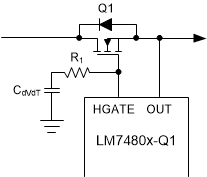SNOSD95C April 2020 – December 2020 LM7480-Q1
PRODUCTION DATA
- 1 Features
- 2 Applications
- 3 Description
- 4 Revision History
- 5 Device Comparison Table
- 6 Pin Configuration and Functions
- 7 Specifications
- 8 Parameter Measurement Information
- 9 Detailed Description
-
10Applications and Implementation
- 10.1 Application Information
- 10.2 Typical 12-V Reverse Battery Protection Application
- 10.3 200-V Unsuppressed Load Dump Protection Application
- 10.4 Do's and Don'ts
- 11Power Supply Recommendations
- 12Layout
- 13Device and Documentation Support
- 14Mechanical, Packaging, and Orderable Information
Package Options
Mechanical Data (Package|Pins)
- DRR|12
Thermal pad, mechanical data (Package|Pins)
- DRR|12
Orderable Information
9.3.2.2 Load Disconnect Switch Control (HGATE, OUT)
HGATE and OUT comprises of Load disconnect switch control stage. Connect the Source of the external MOSFET to OUT and Gate to HGATE.
Before the HGATE driver is enabled, following conditions must be achieved:
- The EN/UVLO pin voltage must be greater than the specified input high voltage.
- The CAP to VS voltage must be greater than the undervoltage lockout voltage.
Voltage at Vs pin must be greater than Vs POR Rising thershold.
For Inrush Current limiting, connect CdVdT capacitor and R1 as shown in Figure 9-3.
 Figure 9-3 Inrush Current Limiting
Figure 9-3 Inrush Current LimitingThe CdVdT capacitor is required for slowing down the HGATE voltage ramp during power up for inrush current limiting. Use Equation 2 to calculate CdVdT capacitance value .

where IHATE_DRV is 55 μA (typ), IINRUSH is the inrush current and COUT is the output load capacitance. An extra resistor, R1, in series with the CdVdT capacitor improves the turn off time.